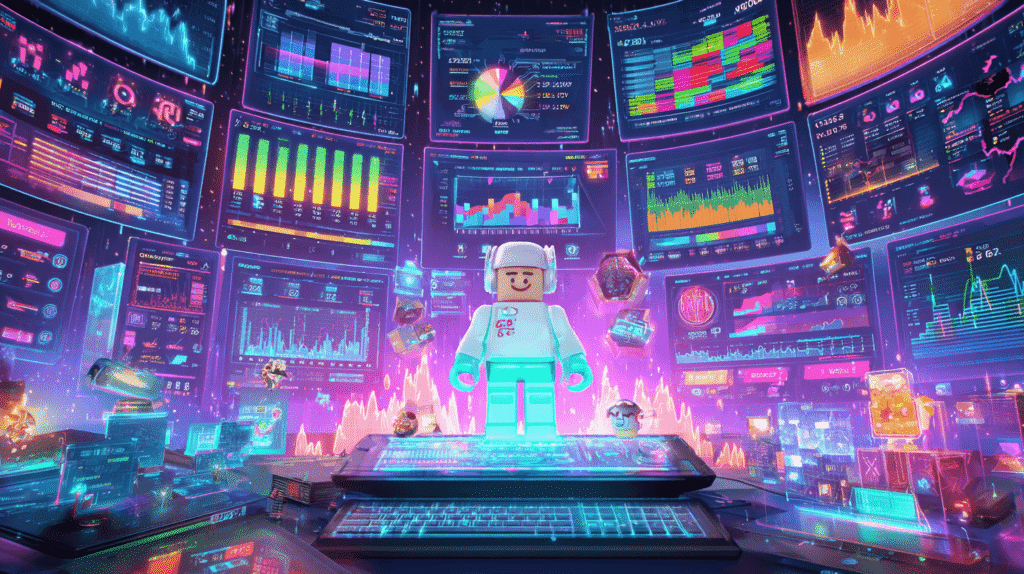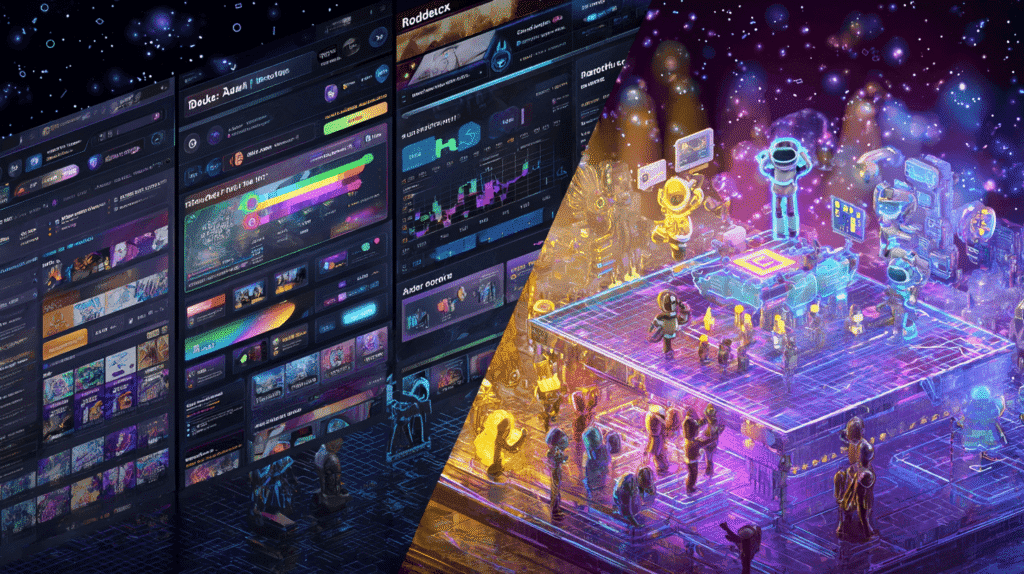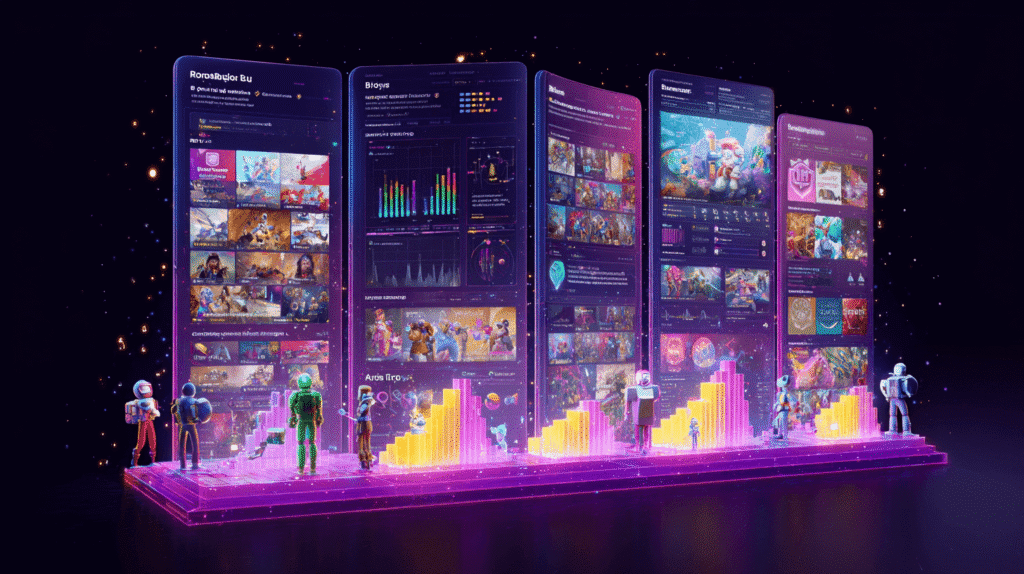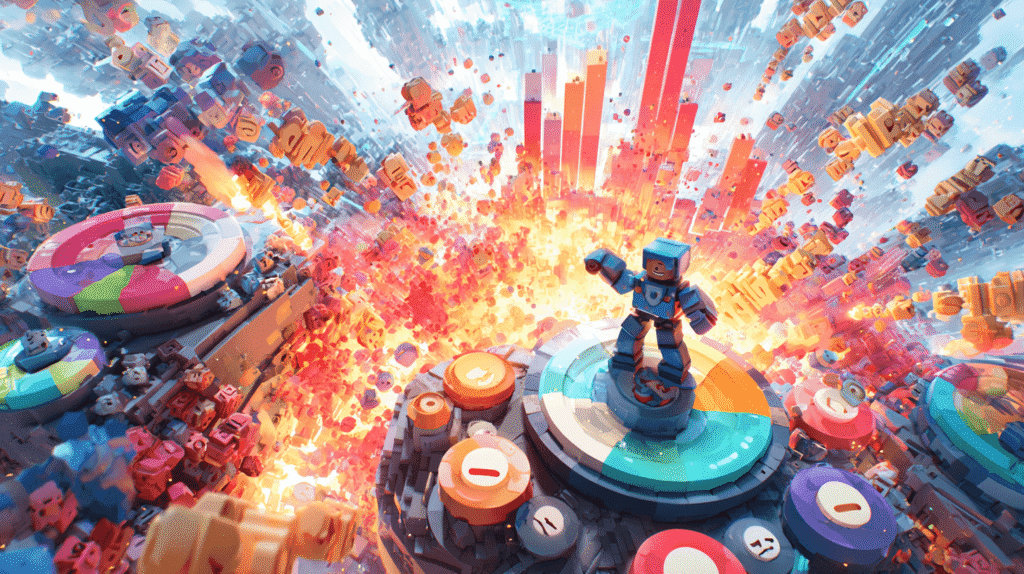Roblox has evolved from a simple gaming platform into a massive digital ecosystem where millions of creators and players interact daily. Understanding Roblox charts—the various metrics, rankings, and statistical tools available—is essential for developers seeking success and players looking to discover trending experiences. This comprehensive guide explores everything you need to know about Roblox charts, from player counts to revenue tracking.
What Are Roblox Charts?

Roblox charts refer to the various ranking systems, statistical dashboards, and analytical tools that track game performance, player engagement, and platform trends. These charts help users identify popular games, monitor concurrent players, track revenue generation, and understand broader platform dynamics.
The platform’s native “Discover” page features several chart categories that showcase games based on different metrics, while third-party analytics sites provide deeper insights into historical data and detailed statistics that aren’t readily available through Roblox’s official interface.
Types of Roblox Charts
Official Roblox Discovery Charts
The Roblox platform features several built-in chart categories designed to help players find engaging content:
- Popular Games: Displays games with the highest current concurrent player counts, updated in real-time
- Top Earning: Showcases games generating the most Robux revenue
- Top Rated: Features games with the highest user ratings and positive engagement
- Recommended For You: Personalized suggestions based on individual play history and preferences
- Up-and-Coming: Highlights games experiencing rapid growth in player engagement
- People Love: Curates games with exceptional retention and satisfaction metrics
Third-Party Analytics Platforms
Several independent websites provide more comprehensive Roblox chart data:
- RoMonitor Stats: Tracks detailed player counts, historical trends, and game performance over extended periods
- Roblox Game Stats: Offers in-depth analytics including visit history, rating trends, and revenue estimates
- RoSearcher: Provides searchable databases of games with filtering options for specific metrics
- RTrack: Monitors game updates, player fluctuations, and long-term performance patterns
For developers looking to enhance their understanding of Roblox analytics and game development strategies, PinkCrow.net offers valuable resources and insights into optimizing game performance and leveraging chart data effectively.
Understanding Key Metrics in Roblox Charts

Concurrent Players (CCU)
Concurrent player count represents the number of users actively playing a game simultaneously. This is arguably the most visible metric on Roblox charts and serves as a primary indicator of a game’s current popularity.
High concurrent player counts typically correlate with:
- Strong game visibility in search and discovery algorithms
- Active developer updates and community engagement
- Viral social media presence or influencer coverage
- Seasonal events or limited-time content updates
- Cross-platform accessibility and mobile optimization
Total Visits vs. Active Users
While total visits show the cumulative number of times players have joined a game, this metric alone doesn’t indicate current popularity or engagement quality. A game with billions of visits but low concurrent players may be past its peak, whereas a newer game with fewer total visits but high CCU demonstrates strong current momentum.
Like-to-Dislike Ratio
The rating system provides insight into player satisfaction. Games with ratios above 85% positive typically indicate:
- Well-implemented gameplay mechanics
- Regular content updates addressing player feedback
- Effective moderation preventing exploiters and toxic behavior
- Balanced monetization that doesn’t feel exploitative
- Strong community management and developer communication
Revenue and Premium Payouts
For developers, revenue charts track Robux earnings through game passes, developer products, and Premium Payouts. Premium Payouts reward developers based on the engagement time Premium subscribers spend in their games, creating an additional revenue stream beyond direct purchases. The Roblox Developer Hub provides comprehensive documentation on monetization strategies and best practices.
How Roblox’s Ranking Algorithm Works

Roblox’s discovery algorithm considers multiple factors when determining chart positions:
Engagement Signals: The algorithm heavily weights session duration, return visit frequency, and player retention rates. Games that keep players engaged for longer periods receive algorithmic boosts.
Growth Velocity: Rapidly increasing player counts signal trending content, prompting the algorithm to feature these games more prominently in discovery charts and recommendation feeds.
Quality Indicators: The platform considers like ratios, report frequencies, and community feedback to filter out low-quality or problematic content from prominent chart positions.
Monetization Balance: Games with fair monetization practices that don’t overwhelm players with pay-to-win mechanics tend to maintain better long-term chart positions as they sustain healthier communities.
Technical Performance: Games with stable server performance, low crash rates, and optimized loading times receive preferential treatment in rankings.
Key Roblox Chart Categories Explained
| Chart Category | Primary Metric | Update Frequency | Best For |
|---|---|---|---|
| Popular | Concurrent Players | Real-time | Discovering active communities |
| Top Earning | Revenue Generation | Daily | Identifying successful monetization |
| Top Rated | Like Percentage | Weekly | Finding quality experiences |
| Up-and-Coming | Growth Rate | Hourly | Spotting emerging trends |
| Featured | Editorial Selection | Variable | Curated high-quality games |
| Recommended | Personal Play History | Real-time | Personalized discovery |
Using Charts as a Developer
Competitive Analysis
Successful developers regularly analyze chart data to understand market trends and player preferences. This involves:
- Identifying gaps in saturated genres where innovation can stand out
- Studying successful games’ update frequencies and content strategies
- Analyzing monetization approaches that maintain positive community sentiment
- Monitoring seasonal trends and planning content around peak engagement periods
- Tracking emerging mechanics or themes gaining traction in up-and-coming charts
Performance Benchmarking
Developers should establish baseline metrics for their games and track progress against similar titles:
- Compare concurrent player counts with games of similar age and genre
- Monitor retention rates by tracking returning player percentages
- Evaluate revenue per active user against category averages
- Assess rating trends following major updates or events
- Identify drop-off points where players typically leave your experience
The Roblox Creator Analytics dashboard provides developers with detailed performance metrics and insights essential for benchmarking and optimization.
Strategic Planning
Chart data informs critical development decisions:
- Update Timing: Release major updates when chart momentum is building rather than during downward trends
- Marketing Investment: Allocate advertising budgets when games are close to breaking into higher chart tiers
- Feature Prioritization: Focus development resources on features that successful chart-topping games implement effectively
- Cross-Promotion: Partner with complementary games at similar chart positions for mutual benefit
- Monetization Optimization: Test pricing and product offerings based on successful patterns in top-earning charts
Historical Trends in Roblox Charts

Evolution of Popular Genres
Roblox’s chart landscape has shifted dramatically over the years:
Early Era (2006-2012): Simple obstacle courses (obbies), tycoons, and survival games dominated charts with straightforward mechanics and basic graphics.
Growth Period (2013-2017): Roleplaying games, simulators, and more sophisticated building games emerged as the platform’s capabilities expanded.
Modern Era (2018-Present): Story-driven experiences, competitive games with esports potential, and social hangout spaces have gained prominence. Games like “Adopt Me!”, “Brookhaven RP,” and “Blox Fruits” have maintained multi-year chart dominance through consistent updates and community engagement.
Peak Concurrent Player Records
| Game | Peak CCU | Date Achieved | Notable Context |
|---|---|---|---|
| Adopt Me! | 1.9+ million | Multiple occasions | Special update events |
| Brookhaven RP | 700,000+ | 2021-2022 | Sustained high engagement |
| Blox Fruits | 800,000+ | 2023-2024 | Major content expansions |
| Pet Simulator X | 600,000+ | 2022 | Limited-time events |
| MeepCity | 200,000+ | 2017-2018 | Peak era dominance |
Strategies to Improve Your Game’s Chart Performance
Optimization for Discovery
To climb Roblox charts, developers must optimize multiple aspects of their games:
- Thumbnail and Icon Design: Create visually compelling, clear thumbnails that communicate your game’s value proposition within seconds
- Title and Description SEO: Use relevant keywords that players actually search for while maintaining natural, compelling copy
- First-Time User Experience: Ensure new players understand core mechanics within 60 seconds to prevent immediate exits
- Mobile Optimization: With most Roblox traffic coming from mobile devices, responsive controls and UI are essential
- Loading Time Reduction: Optimize assets and code to minimize wait times that cause players to abandon before playing
For more comprehensive guidance on game optimization and SEO strategies, PinkCrow.net provides actionable tutorials and resources specifically designed for Roblox developers.
Community Building
Games with strong communities maintain chart positions longer:
- Establish official social media presence on platforms where your target audience congregates
- Create Discord servers or social groups for player communication and feedback
- Respond to comments and engage authentically with your community
- Implement player suggestions when they align with your vision
- Recognize and reward loyal community members through in-game systems
Content Cadence
Regular updates signal active development and give players reasons to return:
- Maintain predictable update schedules so players know when to expect new content
- Balance major feature releases with smaller quality-of-life improvements
- Tie updates to real-world seasons, holidays, or cultural events
- Create limited-time events that drive urgency and concurrent player spikes
- Communicate upcoming features through teasers to build anticipation
Tools for Tracking Roblox Charts

Official Roblox Analytics
Developers with published games access Roblox’s native analytics dashboard, which provides:
- Real-time concurrent player counts and geographical distribution
- Revenue breakdowns by product type and Premium Payouts
- Session duration metrics and engagement funnel analysis
- Device type distribution showing mobile versus desktop players
- Retention cohorts tracking player return patterns
Third-Party Monitoring Services
External tools supplement official data with broader market context:
RoMonitor: Tracks historical player counts with customizable time ranges, allowing developers to identify trends over weeks or months rather than just current snapshots.
Game Analytics Extensions: Browser extensions that add quick-reference statistics to game pages, saving time during competitive research.
Automated Alerts: Some services notify developers when their games or competitors experience significant metric changes, enabling rapid response.
Common Misconceptions
“Higher Charts Guarantee Success”
While chart visibility drives discovery, retention depends on game quality. Many games spike briefly on charts following launch or viral moments but fail to maintain positions due to poor core gameplay loops or technical issues.
“You Need Advertising to Chart”
Organic growth remains possible on Roblox. Games with exceptional quality, unique concepts, or strong word-of-mouth can climb charts without paid advertising, though strategic ad spend accelerates growth. The Roblox advertising platform offers tools for developers ready to invest in promotion.
“Charts Are Manipulated”
Roblox employs sophisticated fraud detection to prevent artificial inflation through bots or fake accounts. While no system is perfect, the platform actively removes games using illegitimate tactics, making manipulation both difficult and risky.
“Only New Games Can Chart”
Many top-charting games are years old, maintained through consistent updates. Longevity and sustained quality often outperform the temporary advantages of novelty.
The Future of Roblox Charts
Emerging Trends
Several developments are shaping how Roblox charts will evolve:
AI-Driven Recommendations: Machine learning algorithms are becoming more sophisticated at matching players with games that fit their specific preferences beyond simple genre categories.
Cross-Platform Metrics: As Roblox expands to more devices including consoles, charts may begin distinguishing between platform-specific popularity or providing unified cross-platform rankings.
Creator Economy Expansion: New monetization features like subscriptions and paid access may create additional chart categories focusing on sustainable revenue models rather than just concurrent players.
Quality Over Quantity: The platform continues refining algorithms to prioritize engagement quality and player satisfaction over raw player counts, potentially reshaping what it means to “chart.”
Best Practices for Using Chart Data
For Players
- Use charts as starting points for discovery, not definitive quality indicators
- Explore up-and-coming and niche categories to find unique experiences before they become mainstream
- Check multiple chart categories to match your specific interests rather than just playing what’s most popular
- Read recent reviews alongside chart positions for current game state assessment
- Revisit games periodically as major updates can transform experiences
For Developers
- Track your own games’ metrics consistently using both official and third-party tools
- Study successful competitors but focus on authentic innovation rather than cloning
- Use chart data to validate ideas before committing to major development efforts
- Celebrate incremental progress rather than obsessing over top chart positions
- Balance data-driven decisions with creative vision and player feedback
The Roblox Developer Forum provides an excellent community space where developers share insights, strategies, and experiences related to chart performance and game optimization.
Conclusion
Roblox charts serve as essential navigation tools in the platform’s vast ecosystem, helping players discover engaging experiences while providing developers with critical performance insights. Understanding how these charts function, what metrics drive rankings, and how to interpret trend data empowers both creators and players to make informed decisions.
For developers, chart analysis should inform strategy without dictating it—successful games balance data insights with creative vision and authentic community building. For players, charts offer valuable discovery tools that work best when combined with personal exploration and willingness to venture beyond just the top-ranking titles.
As Roblox continues evolving, charts will remain central to platform navigation, though the specific metrics and categories may shift to reflect new priorities and technologies. Staying informed about these systems while maintaining focus on quality, engagement, and community ensures long-term success regardless of algorithmic changes.
Whether you’re a player seeking new adventures or a developer aiming to optimize your game’s performance, resources like PinkCrow.net alongside official Roblox documentation provide valuable guidance for navigating the dynamic world of Roblox charts.



